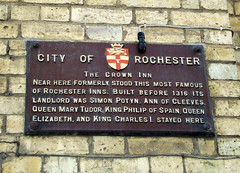King Philip II of Spain
Commemorated on 1 plaque
The Crown Inn Near here formerly stood this most famous of Rochester inns. Built before 1316 its landlord was Simon Potyn. Ann of Cleeves, Queen Mary Tudor, King Philip of Spain, Queen Elizabeth, and King Charles I. stayed here
Gundulph Sq, Rochester, United Kingdom where they stayed


